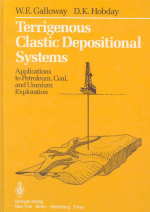Добрый день, Коллеги. Важное сообщение, просьба принять участие. Музей Ферсмана ищет помощь для реставрационных работ в помещении. Подробности по ссылке
Terrigenous clastic depositional systems. Applications to petroleum, coal, and uranium exploration / Системы терригенно-обломочных отложений. Применение в разведке нефти, угля и урана
Nonrenewable energy resources available in very large quantities are limited to heavy hydrogen and dry geothermal energy. Large-scale renewable resources are solar and atmospheric electricity (Moody, 1978). These four may be regarded as the ultimate energy sources, but they are unlikely to contribute significantly to the total energy budget for at least the next few decades. Synthetic fuels are already in production, but widespread conversion is being held back by economic and environmental considerations. Wind, water, and biomass conversion will play an enlarged, but still relatively minor, role. This leaves coal, uranium, and petroleum to provide the bulk of the immediately foreseeable energy requirements.The use of coal goes back thousands of years to its combustion in Bronze Age funeral pyres. It was used by the ancient Greeks and Romans, and subsequently by the American Indians, Chinese, and European nations, where it gradually supplanted animals, wind, water, and wood as the main energy source, fueling the Industrial Revolution. Although superseded this century by petroleum, coal has made a strong comeback since the early 1970s and is on the ascent. Petroleum, too, has a long history of humanutilization, being employed in warfare and embalming prior to 500 вс, and, subsequently, in medicines and street lamps. A petroleum field was established as early as 211 вс in Szechwan, China (Halbouty, 1980), but only with the 1859 Titusville discovery was the modern petroleum industry presaged. The degree to which Western nations became reliant on petroleum in motive and stationary power sources was made apparent by the 1973 OPEC oil embargo. Uranium, in contrast, has been used for less than 50 years, with consumption accelerated by World War II weapons research and, from 1968 to 1973, by fuel-mineral demand. <...>




